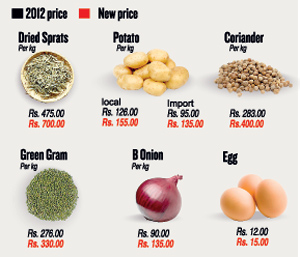News
Backs to the wall, families face swathe of price rises
Whether it’s a lunch packet from the local bath kade or children’s school van fees, many essential goods and services will rise in price in coming weeks due to the impact of Budget’s direct and indirect taxes on low-income groups. Government statistics show the rises are hitting urban families most, with expenditure outstripping income and households skimping on medical care on food quality to make ends meet.

Prices set to rise: Let’s see what we can buy. Pix by Indika Handuwala
Prices of some essential dry rations have already risen. Last year, a coconut cost Rs 38 but today the average price is Rs 50. A kilo of coriander which cost Rs 283 last year is now Rs 400. Local Bombay onions have shot up from Rs 90 a kilo and the imported variety from Rs 70 to Rs 135.
The poor man’s favourite, dried sprats, have also seen a big increase from Rs 475 a kilo to Rs 700. Coconut oil, previously Rs 180 for 750ml, is now Rs 220-250. Although the Health Ministry recommends having green gram for breakfast, today 1kg of green gram is sold at Rs 330, up Rs 60 from last year.
S. Abeywickrema, owner of a shop that sells hundreds of lunch packets to office employees in the city, said he was planning to increase prices by Rs 10 a packet from next year. “We’re losing money at the moment,” he said. “Many shops have reduced the number of vegetables served and even opt for cheap vegetables, which raises questions about the quality of the food.”
Some food shop owners are considering charging about Rs 2 – Rs 5 more for stringhoppers, hoppers and parathas.
Bread will also cost more in the future given the wheat flour price increase. According to the Department of Census and Statistics’ Household Income and Expenditure Survey 2012/13, the average monthly household income was Rs 46,207 (this includes earnings of at least two persons) but an average four-member urban household had to bear expenditure of Rs 59,000 for this period. This includes food expenditure of Rs 18,513.
Rural families’ expenditure stayed at Rs 28,331 and estate workers’ spending at at Rs 25,580. The public are not convinced that the relief offered in the Budget would provide realistic help. Upali Gunesekare, 52, a state sector employee in Colombo, said the Rs 1,200 increase in salaries was eyewash given the price increase in daily essentials such as onions, green gram, coconut, dhal, sprats, canned fish, bread, transportation and communication charges.
“It is ironic that this Budget has given a reduction in pet food prices but increased the price of food consumed by people,” he commented. ”Apart from this, I’m concerned about the utility bills that are forever increasing with different fees and surcharges.”

Chitra Tennakoon, 47, who has two children in university and one in school said the cost of living was unbearable for single parents. “The cost for one child’s education is about Rs 8,000. As I am a government servant my children are not eligible for Mahapola and other scholarships offered to university students. We are finding the increase in prices of basic daily goods intolerable,” said Ms Tennakoon, a widow.
“It’s useless to reduce the price of rice if the prices of accompaniments are increasing,” pointed out D. Fernando, a mother in Moratuwa. She added that the driver of her children’s school van had given notice of a rise in charges due to the cost of living.
A recent survey of 2200 households by by Social Indicator revealed that 31.8 per cent said that their financial situation had deteriorated in the past two years.
“The quality of food consumed by people appears to be the most affected by this financial strain with 30.6 per cent admitting that they have cut back on the quality of food while 20 per cent say that they have either not taken medicine or undergone medical treatment at a time it was needed,” the survey report said.
Research Associate at the Social Scientists’ Association Balasingham Skanthakumar said what the public wanted was reduction in costs and unemployment and more investment in education “rather than port cities, skyscrapers, Formula 1 races or tax concessions on bows and ties”.
He said the Budget contained only small concessions targeted at key voting groups such as the farming and fishing communities. People’s Liberation Front (JVP) Central Committee member and former MP Lakshman Nipunaarachchi said the price of a basket of goods was Rs 25,000 when President Mahinda Rajapaksa came into power and was now Rs 49,000.
He said the rise in the farmers’ pension pool was misleading, and by increasing the pension access age from 60 to 63 years farmers will have to provide more contributions to the fund. Although the government had allocated Rs 1 billion for farmers’ pensions this sum needed to be doubled.
Mr Nipunaarachchi said the price rises of staple goods hit all families hard. “The tax increase for coriander is Rs 300. All households have to bear the tax on this simple spice that is used for a common cold or a daily curry. The state is hoping to collect many indirect taxes from the public through essential goods while giving a meagre Rs 1,200 salary increase for state sector employees,” he said.


